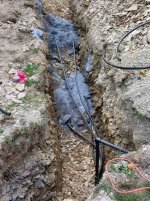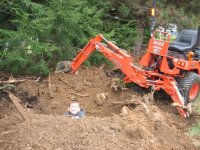You are using an out of date browser. It may not display this or other websites correctly.
You should upgrade or use an alternative browser.
You should upgrade or use an alternative browser.
BX23 trenching speed
- Thread starter ESM
- Start date
- Views: 5342
-
- Tags
- kubota bx23
/ BX23 trenching speed
#11
blackmajicwoman
Silver Member
ESM,
With my BX1500 and Woods BH6000, I dug 100' long total, 4' deep, 1' wide. Being quite the novice, I had to raise the stablizers, move the tractor a few feet, then start all over again. I laid 4" pref'd PVC lined with fabric sock, and connected all of the proper joints to make one run from 2 downspount to a catch basin. I then backfilled and smoothed out. This took me about 8-10 hours. I hope this gives you a little insight, like double the time if you want the trench 24" wide. Also, the deeper I dug, the harder it got, as I was more limited and working towards limits of the length of the boom and dipper. A good estimate from me would be 14-16 hours/100'. Very do-able and fun, just need a little patience.
With my BX1500 and Woods BH6000, I dug 100' long total, 4' deep, 1' wide. Being quite the novice, I had to raise the stablizers, move the tractor a few feet, then start all over again. I laid 4" pref'd PVC lined with fabric sock, and connected all of the proper joints to make one run from 2 downspount to a catch basin. I then backfilled and smoothed out. This took me about 8-10 hours. I hope this gives you a little insight, like double the time if you want the trench 24" wide. Also, the deeper I dug, the harder it got, as I was more limited and working towards limits of the length of the boom and dipper. A good estimate from me would be 14-16 hours/100'. Very do-able and fun, just need a little patience.
techman,
Thanks for all the great information and pictures! I'm expecting to have two zones as well. We'll be converting our 2nd floor with the new addition we're adding over the garage to one zone and the first floor and basement will be the second zone. The basic plan is to use the geo unit for the 2nd story and use our existing air source HP for the rest of the house. If I can swing it though I would sure like to rip out our current Ruud HP and use Geo for both.
Your thoughts on the wider trench make sense and I will definitely check into that. Is the gravel screening a regional requirement? From your pictures it seems like you have a lot of shale and adding the screening makes sense. My soil is more clay like which I would think would make a pretty good heat transfer medium because it can pack tightly without retaining any tiny air spaces. I assume that is why you urge not to use sand. Should the trenches be compacted at all when backfilled?
The hot water is certainly another excellent benefit! I didn't realize there would be any water heating advantage during the heating season. I'm sure it is even better in the summer!
So your two systems share the same trench? Is the piping shared too?
How would one go about learning how to make the thermal fusion connections and what special tools are required? Even if I will not end up doing this project myself I would like to understand as much as possible about the installation and operation. These systems fascinate me.
Thanks for all the information, your post has certainly given me a much better understanding of the amount of work required.
So you can get an idea about the soil conditions here, I've included a couple of pics from this past summer when my little boy helped me remove the stumps left from a couple of pine trees we took down.
blackmajicwoman,
That helps a lot to put it in perspective. I agree it is defiantly do-able and would be a fun project. I need to gather more information about the specific trench requirements I will need, pricing and so forth. I would love to do the project myself but it's probably just not piratical. Practicality isn't everything though /forums/images/graemlins/smile.gif
Thanks for all the great information and pictures! I'm expecting to have two zones as well. We'll be converting our 2nd floor with the new addition we're adding over the garage to one zone and the first floor and basement will be the second zone. The basic plan is to use the geo unit for the 2nd story and use our existing air source HP for the rest of the house. If I can swing it though I would sure like to rip out our current Ruud HP and use Geo for both.
Your thoughts on the wider trench make sense and I will definitely check into that. Is the gravel screening a regional requirement? From your pictures it seems like you have a lot of shale and adding the screening makes sense. My soil is more clay like which I would think would make a pretty good heat transfer medium because it can pack tightly without retaining any tiny air spaces. I assume that is why you urge not to use sand. Should the trenches be compacted at all when backfilled?
The hot water is certainly another excellent benefit! I didn't realize there would be any water heating advantage during the heating season. I'm sure it is even better in the summer!
So your two systems share the same trench? Is the piping shared too?
How would one go about learning how to make the thermal fusion connections and what special tools are required? Even if I will not end up doing this project myself I would like to understand as much as possible about the installation and operation. These systems fascinate me.
Thanks for all the information, your post has certainly given me a much better understanding of the amount of work required.
So you can get an idea about the soil conditions here, I've included a couple of pics from this past summer when my little boy helped me remove the stumps left from a couple of pine trees we took down.
blackmajicwoman,
That helps a lot to put it in perspective. I agree it is defiantly do-able and would be a fun project. I need to gather more information about the specific trench requirements I will need, pricing and so forth. I would love to do the project myself but it's probably just not piratical. Practicality isn't everything though /forums/images/graemlins/smile.gif
Attachments
ESM:
The screenings are recommended with all soils. Even with a fine clay, you would have gaps and "bubbles" of air along the pipe, which would reduce the coupling efficiency. Coupling to the pipe is critical, so the screenings provide a good way to provide a gapless thermal path to the soil. In the big picture, the cost of the screenings are not much and easy to handle with the Kubota.
As for my system, the two units are fed by one loop, sized to handle both systems. So there is one piping system and one circulator panel. The two heat pumps are piped in parallel. My two are 2 and 1.5 ton which are very close in design, so nothing was needed to balance the flow between them as they had equal pressure drops.
As for special tools, only the thermal fusion tool is needed. It costs about a grand, but there is one internet company that will rent by the day. I was able to rent mine from my wholesaler for ClimateMaster, who also gave me the training.
If you go through the effort to put in a loop, it would be foolish to not convert the whole house to geo. After the loop was in, the additional cost for a second unit would quickly pay for itself.
If you put a split in your upstairs, you will need a certified/licensed HVAC guy to do the connections, pumpdown and chagring with freon. Tools and equipment are needed for that job as well.
If people are interested in the job, I could post a more complete story of the job. I would move it to Rural Living rather than this forum.
If anyone is interested, let me know.
paul
The screenings are recommended with all soils. Even with a fine clay, you would have gaps and "bubbles" of air along the pipe, which would reduce the coupling efficiency. Coupling to the pipe is critical, so the screenings provide a good way to provide a gapless thermal path to the soil. In the big picture, the cost of the screenings are not much and easy to handle with the Kubota.
As for my system, the two units are fed by one loop, sized to handle both systems. So there is one piping system and one circulator panel. The two heat pumps are piped in parallel. My two are 2 and 1.5 ton which are very close in design, so nothing was needed to balance the flow between them as they had equal pressure drops.
As for special tools, only the thermal fusion tool is needed. It costs about a grand, but there is one internet company that will rent by the day. I was able to rent mine from my wholesaler for ClimateMaster, who also gave me the training.
If you go through the effort to put in a loop, it would be foolish to not convert the whole house to geo. After the loop was in, the additional cost for a second unit would quickly pay for itself.
If you put a split in your upstairs, you will need a certified/licensed HVAC guy to do the connections, pumpdown and chagring with freon. Tools and equipment are needed for that job as well.
If people are interested in the job, I could post a more complete story of the job. I would move it to Rural Living rather than this forum.
If anyone is interested, let me know.
paul
techman
If you can use one loop for both systems then I would be crazy to not do both. You mentioned in your original post post about the difficulty in leveling the second layer in the trench. I was speaking to local installer on the phone last week and he said what they do is lay the pipe in the bottom, then use hangers (like big staples) to secure the next layer of pipe to the trench wall 2' up. Then they backfill as they lay the pipe in. The hangers make sense but I think I would want to wait on the backfill as you did so everything can be tested.
In any case I for one would love to hear more details about your project. As you point out, I'm sure you would reach more people through Rural Living then this Kubota forum.
Thanks again.
If you can use one loop for both systems then I would be crazy to not do both. You mentioned in your original post post about the difficulty in leveling the second layer in the trench. I was speaking to local installer on the phone last week and he said what they do is lay the pipe in the bottom, then use hangers (like big staples) to secure the next layer of pipe to the trench wall 2' up. Then they backfill as they lay the pipe in. The hangers make sense but I think I would want to wait on the backfill as you did so everything can be tested.
In any case I for one would love to hear more details about your project. As you point out, I'm sure you would reach more people through Rural Living then this Kubota forum.
Thanks again.
5030tinkerer
Gold Member
No one that I've run into is suggesting that the 15' horizontal boring depth is required, although there are some who provided stories of the ground drying out and not providing proper thermal conduction in Nebraska last year as a result of a drought and having pipe buried too shallow.


